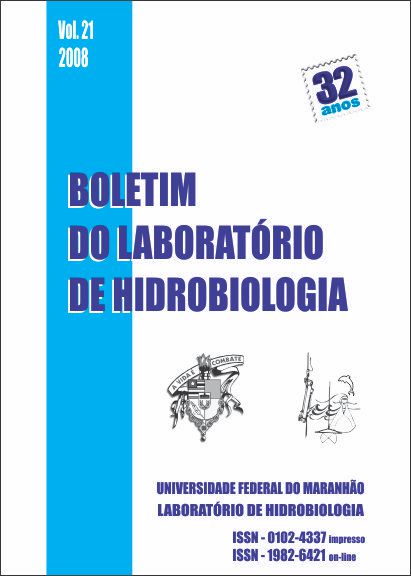PRIMEIRO REGISTRO DA ASSOCIAÇÃO ENTRE O CARANGUEJO Libinia ferreirae (CRUSTACEA; DECAPODA; MAJIDAE) E A Medusa lychnorhiza lucerna (CNIDARIA; SCYPHOZOA; RHIZOSTOMEAE) PARA O GOLFÃO MARANHENSE
DOI:
https://doi.org/10.18764/Resumo
As medusas estão entre os maiores invertebrados solitários do ambiente pelágico marinho sendo agregadoras de grande diversidade de espécies marinhas. Nos últimos anos, vários relatos de associações de águas-vivas com vertebrados e invertebrados marinhos têm sido registrados, mas associação entre cifomedusa Lychnorhiza lucerna e caranguejos ainda é pouco conhecida. Os objetivos desta nota são registrar a presença de Lychnorhiza lucerna para o litoral maranhense, além de notificar a associação entre a espécie e o Decapoda Libinia ferreirae. Em março de 2005 e março de 2006, observamos a associação no estuário do Rio Cururuca (município de São José de Ribamar), onde centenas de águas-vivas foram encontradas. Foram coletados manualmente 35 espécimes do caranguejo-aranha Libinia ferreirae., os quais estavam nos braços orais e na umbrela de medusas da espécie Lychnorhiza lucerna. Os decapodas foram fixados em solução de formaldeído a 4% e, atualmente, encontram-se preservados em etanol 70%.
Palavras-chave: Maranhão, Decapooda, Água-viva..
Abstract
First record of the association between the spidercrab Libinia ferreirae (Crustacea; Decapoda; Majidae) and the scyphomedusa Lychnorhiza lucerna (Cnidaria; Scyphozoa; Rhizostomeae) for the Maranhão Gulf
The jellyfishes are among the greatest solitary invertebrates of the pelagic marine environment, associating with diverse marine species. In the last years, jellyfish association had been registered with several vertebrate and invertebrate groups, however Lychnorhiza lucerna - crabs association is poorly known. The purposes of this note are to register the presence of Lychnorhiza lucerna in the coast of Maranhão state, and to communicate the Lychnorhiza lucerna - Decapoda association. In March/2005 and March/2006, we observed the association in the estuarine system of Cururuca’s River (São José de Ribamar municipe), where hundreds of jellyfishes were found. Thirty-five specimens of Libinia ferreirae. were collected by hand, which were located in the oral arms or inside the umbrella of the jellyfish. The organisms were previously fixed in 4% formaldehyde solution and then preserved in 70% ethanol.
Key words: Maranhão, decapods, jellyfish
Downloads
Referências
BROWNE, J.G. & KINGSFORD M.J. 2005. A commensal relationship between the scyphozoan medusae Catostylus mosaicus and the copepod Paramacrochiron maximum. Mar. Biol., 146: 1157-1168.
BRUCE, A.J. 1972. An Association between a Pontoniinid shrimp and a rhizostomatous scyphozoan. Crustaceana,. 23: 300-302.
CORNELIUS, P. F. S. 1997. Class Scyphozoa - jellyfish. In: RICHMOND, M. D. (ed). A guide to the seashores of Eastern Africa and the Western Indian Ocean islands. Stockholm: SIDA/ Department for Research Cooperation, p. 122-125.
HADDAD, V., JR.., SILVEIRA, F. L. DA, CARDOSO, J. L. C. & MORANDINI, A. C. 2002. A report of 49 cases of cnidarian envenoming from Southeastern Brazilian coastal waters. Toxicon, 40(10):1445-1450.
MARTIN, J.W. & KUCK H.G. 1991. Faunal associates of an undescribed species of Chrysaora (Cnidaria, Scyphozoa) in the Southern California Bight, with notes on unusual occurrences of other warm water species in the area. Bull. Calif. Acad. Sci.,. 90(3): 89-101.
MELO, G.A.S. 1996. Manual de Identificação dos Brachyura (caranguejos e siris) do litoral brasileiro. São Paulo: Ed. Plêiade, FAPESP, 604 p.
MIANZAN, H. W. & CORNELIUS, P. F. S. 1999. Cubomedusae and Scyphomedusae. In: BOLTOVSKOY, D. (ed.) South Atlantic Zooplankton, vol. I. Leiden: Backhuys. p. 513-559.
MORANDINI, A. C. 2003. Deep-sea medusae (Cnidaria: Cubozoa, Hydrozoa and Scyphozoa) from the coast of Bahia (Western South Atlantic, Brazil). Mitt. hamb.zool. Mus. Inst., 100: 13-25.
MORANDINI, A. C., ASCHER, D., STAMPAR, S. N. & FERREIRA, J. F. V. 2005. Cubozoa e Scyphozoa (Cnidaria: Medusozoa) de águas costeiras do Brasil. Iheringia, Sér. Zool., 95(3): 281-294.
MORANDINI, A. C., SOARES, M. O., MATTHEWS-CASCON, H. & MARQUES, A. C. 2006. A survey of the Scyphozoa and Cubozoa (Cnidaria, Medusozoa) from the Ceará coast (NE Brazil). Biota Neotropica, 6: 1-8.
MOREIRA, M.G.S. 1961. Sobre Mastigias scintillae sp. nov. (Scyphomedusae, Rhizostomidae) das costas do Brasil. Bolm Inst. Oceanogr. S. Paulo, 11: 5-30.
NOGUEIRA, M. & HADDAD, M. A., 2005. Lychnorhiza lucerna Haeckel (Scyphozoa, Rhizostomeae) and Libinia ferreirae Brito Capello (Decapoda, Majidae) association in southern Brazil. Rev. Bras. Zool., 22(4): 908-912.
NOGUEIRA, M. & SILVA, J. L., 2005. Associações entre medusas (Cnidaria) e isópodos (Crustacea) nos litorais do Paraná e Santa Catarina, Brasil. Acta Biol. Paran., Curitiba, 34(1, 2, 3, 4): 127-138.
PAGÈS, F. 2000. Biological associations between barnacles and jellyfish with emphasis on the ectoparasitism of Alepas pacifica (Lepadomorpha) on Diplulmaris malayensis. J. Nat. Hist., 34: 2045-2056.
PHILLIPS, P.J., BURKE, W.D. & KEENER, E.J. 1969. Observations on the trophic significance of jellyfishes in Mississipi Sound with quantitative data on the associative behavior of small fishes with medusae. Trans. Am. Fish. Soc., 4: 703-712.
PRADO-ROSAS, M.C.G., SEGURA-PUERTAS, L., ÁLVAREZ-CADENA, J.N. & LAMOTHE-ARGUMEDO, R. 2000. Opechona pyriforme metacercaria (Trematoda: Lepocreadiidae) in Eirene láctea (Cnidaria: Hydroidomedusae) from a reef lagoon in the Mexican Caribbean Sea. Ann. Inst. Biol. Univ. Nac. Aut. México, Sér. Zool., 71(1): 1-6.
PURCELL, J. E., GRAHAM, W. M. & DUMONT, H. J. (eds.). 2001. Jellyfish blooms: ecological and societal importance. Hydrobiologia, 451:1-333.
SHANKS, A.L. & GRAHAM, W.M.. 1989. Chemical defense in a Scyphomedusa. Mar. Ecol. Progr. Ser., 45: 81-86.
SORRARAIN, D., RAMIREZ, F.& MIANZAN, H.. 2001. Hyperoche medusarum (Kroyer, 1838) (Amphipoda, Hyperiidae) and Mnemiopsis mccradyi (Mayer, 1900) (Ctenophora): a new host and first record of this association for the southwestern Atlantic. Crustaceana, 74(4): 407-410.
VANNUCCI-MENDES, M. 1944. Sobre a larva de Dibothriorhynchus dinoi sp. n. parasita dos Rhizostomata (Cest. Tetrarhynchidea). Arq. Mus. Paran., 4(2): 47-81.
ZAMPONI, M.O. 2002. The association between the medusa Lychnorhiza lucerna (Scyphomedusae, Rhizostomeae) and the decapod Libinia spinosa (Brachyura, Majidae) - the first record for neritic waters of Argentina [in Russian]. Biologiya Morya, 28: 294-296.






